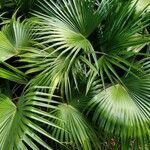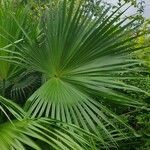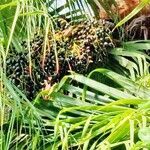A solitary palm. The trunk is 15 m tall and 20-30 cm across. It is rough with leaf scars. The leaves have leaflets like fingers on a hand. The leaf stalks are 1.8 m long. There are spines that curve back along the edge. The leaves are almost round in outline. They are 1.2-1.6 m across. They are divided into 50-90 segments. These hang down at the tips. The flowering stalks are 1 m long. They are branched 3 times.
Leaves: segment apices lax. Inflorescences with single primary axis and 3 orders of branching. Fruits usually oblong or olive-shaped (rarely globose), ripening from green to blue-green. 2n = 36.




